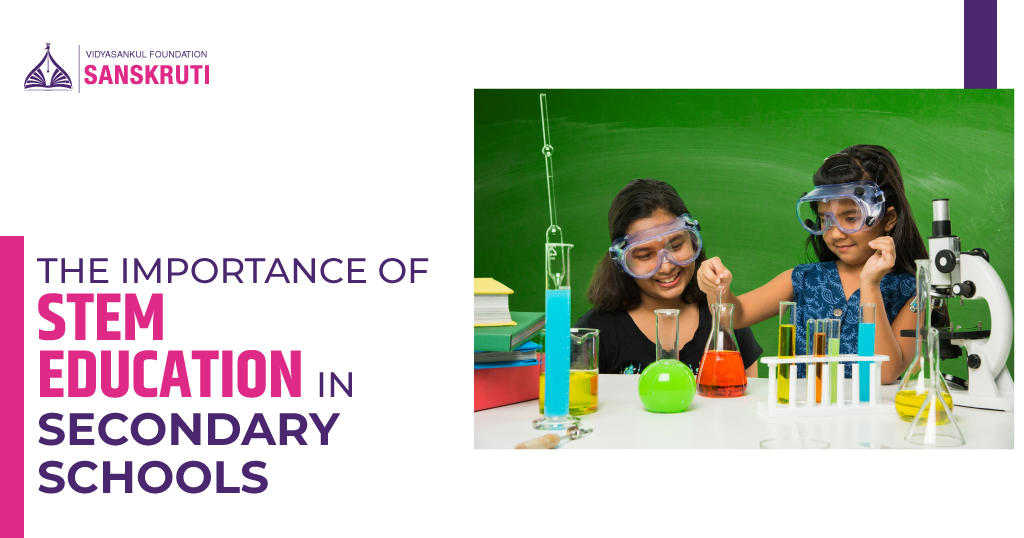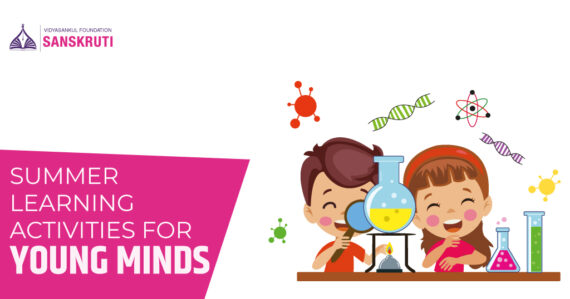Have you ever wondered how prepared your child is for the future in an ever-changing, technology-driven world? With rapid advancements in science, technology, and innovation impacting almost every industry, it is crucial to equip the next generation with the right skills. STEM education—covering Science, Technology, Engineering, and Mathematics—lays the foundation for success in modern-day careers and beyond. But what makes STEM education so vital in secondary school, and how Sanskruti World School, the best secondary school in Boisar, Palghar, ensure your child is future-ready? Let’s get into the details.
What is STEM Education?
STEM education integrates the disciplines of Science, Technology, Engineering, and Mathematics into a cohesive, interdisciplinary learning approach. Its focus goes beyond traditional classroom teaching. Rather than learning each subject in isolation, STEM encourages students to make connections between concepts and apply them to real-world scenarios.
For example, students might work on developing a robotic arm in an engineering project where they’ll use principles of computer programming (technology), physics (science), and geometry (mathematics). STEM teaching methodologies emphasize critical thinking, creativity, problem-solving, and collaboration—skills that are invaluable for both academic achievement and career success. Schools that prioritize STEM programs ensure students are prepared for the new challenges of a global, technology-focused society.
Benefits of STEM Education in Secondary Schools
1. Fosters Critical Thinking and Problem-Solving Skills
One of the biggest benefits of STEM education in secondary schools is its emphasis on fostering critical thinking and problem-solving skills. The nature of STEM subjects is such that students are often required to analyze situations, hypothesize solutions, and test claims. This process encourages logical reasoning and allows students to approach problems in innovative ways.
For example, learning coding in technology classes or conducting experiments in science labs teaches students how to question information, identify errors, and refine strategies to achieve precise results. These skills extend beyond the classroom and are applicable in nearly every facet of life, including personal decision-making and professional tasks. Secondary schools often integrate STEM activities to ensure students become adept problem solvers and critical thinkers from an early age.
2. Prepares Students for the Future Job Market
As technology continues to dominate industries worldwide, there is a growing need for skilled professionals in STEM-related fields. Careers in artificial intelligence, data analysis, engineering, biotechnology, and software development are in demand. STEM education in secondary schools prepares students for these opportunities by providing a solid foundation in science, technology, engineering, and mathematics.
In addition, introducing STEM concepts in secondary school builds familiarity and competency that may later translate into academic and career choices. It helps students imagine themselves in roles like engineers, innovators, or researchers. With ever-evolving advancements in technology, having a background in STEM ensures adaptability to future jobs, many of which do not even exist today. Schools offering robust STEM programs are playing a critical role in shaping tomorrow’s workforce.
3. Encourages Innovation and Creativity
Contrary to the belief that STEM is purely analytical, it also inspires creativity and innovation. STEM education encourages students to think outside the box and develop inventive solutions. Whether they are designing prototypes in engineering classes or conducting science projects, students have opportunities to experiment and create, fostering an entrepreneurial mindset.
By embracing trial and error while working on practical assignments, students are not afraid to take risks. They explore different possibilities and gain hands-on experience connecting theoretical knowledge with real-world applications. This creative problem-solving mindset is essential for innovation, as it arms students with the confidence to solve complex challenges in unique ways.
4. Builds Teamwork and Collaboration Skills
STEM education often involves group projects, experiments, and competitions, teaching students the value of teamwork and effective collaboration. Within these group settings, students learn how to share ideas, delegate responsibilities, and respect the perspectives of others. These collaborative abilities are vital for thriving in team-oriented work environments in the future.
Furthermore, STEM’s collaborative environment mirrors how modern workplaces operate, where people from diverse skill sets and locations work together to achieve goals. By familiarizing students with collaboration early on, schools better prepare them for professional scenarios. This collaborative approach is something that leading schools, including Sanskruti World School, the best secondary school in Boisar, Palghar, prioritize through dedicated STEM-based activities.
5. Develops Technological Literacy
In the current digital era, technological literacy is no longer optional; it’s a necessity. STEM education focuses on equipping students with technological proficiency, ensuring they understand and can interact with the tools shaping modern society. From learning computer programming languages to understanding data analysis software, students gain a robust knowledge base of technology.
This technological literacy helps students make informed decisions regarding which tech tools to implement in various scenarios, thereby enhancing both productivity and efficiency. Furthermore, it strengthens their ability to keep up with advancements in technology, preparing them for careers linked to automation, AI, and renewable energy solutions.
6. Boosts Confidence and Leadership Skills
STEM education empowers students by encouraging them to tackle challenges head-on, thereby boosting their self-confidence. As students engage in projects that push their intellectual boundaries, they develop the resilience needed to overcome obstacles and take ownership of their learning journeys. STEM also offers leadership opportunities through science fairs, robotics competitions, and group presentations.
When students achieve tangible outcomes, such as solving mathematical problems or successfully coding a software program, their confidence invariably grows. These experiences not only help build leadership traits but also make students better communicators and decision-makers, skill sets crucial for their future endeavors.
7. Promotes Gender Inclusivity
Despite significant progress, STEM fields continue to experience gender disparities. Introducing STEM education at the secondary school level can bridge this gap by encouraging both boys and girls to explore STEM-related topics equally. Schools that promote inclusive STEM education help break stereotypes and encourage students to pursue their interests regardless of gender norms.
When girls are given equal opportunities to work on STEM projects, participate in competitions, or even take part in coding boot camps, they gain the confidence to follow STEM career paths. This leads to a more diverse workforce, which research shows produces better innovation and results in STEM industries.
8. Strengthens Analytical and Quantitative Skills
Mathematics and engineering components of STEM contribute significantly to strengthening analytical and quantitative skills. These skills enable students to evaluate data, recognize patterns, and draw conclusions effectively. STEM education emphasizes using evidence-based reasoning to solve real-world challenges.
Whether it’s calculating trajectories in physics, understanding genetics in biology, or studying algorithms in computer science, the analytical rigor prepares students for demanding fields like data science, economics, or biomedical sciences. Schools that nurture these skills are vital in creating intellectually capable individuals ready for higher education and professional life.
Empower Your Child with STEM Education
STEM education is vital for building a generation of thinkers, innovators, and problem-solvers equipped to meet the challenges of the modern world. From developing critical thinking and technical skills to promoting inclusivity and lifelong learning, STEM is the gateway to thriving in the future economy.
As one of the best secondary schools in Boisar, Palghar, we emphasize STEM education. With well-equipped labs, collaborative learning experiences, and expert guidance, we strive to set the foundation for successful career paths aligned with your child’s interests.
Admissions are now open for the new academic session! Choose Sanskruti World School for a holistic education experience and give your child the advantage of world-class learning!





